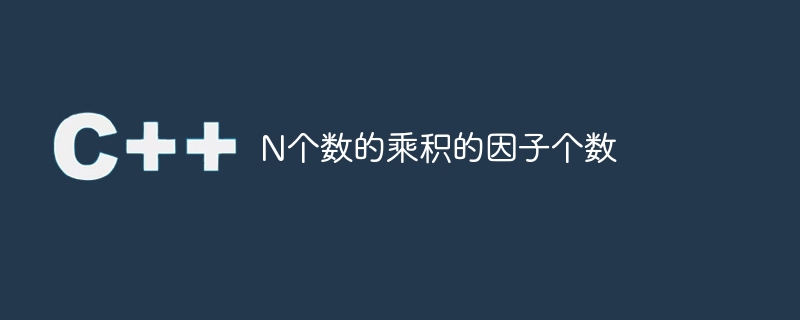N個數的乘積的因子個數

一個數的除數是能夠將其整除而沒有任何餘數的數。換句話說,一個數n的除數是當乘以任何其他整數時得到n的數。它也可以被稱為一個數的因數。
Dividend ÷ Divisor = Quotient.
例如,如果我們用5除以60,我們將得到12,反之亦然,因此,12和60可以被認為是60的除數。
乘以N個數的因子數
給定任務是找到給定數字的乘積的除數數量。讓我們透過一個例子來理解這個問題。
假設我們給了數字6、6和10。這些數字的乘積是120,120的約數是1、2、3、4、5、6、8、10、12、15、20、24、30、40、60、120。因此,輸出應為16。
Input: 6, 2, 10 Output: 16
使用取模運算子
實現這一目標的一種方法是使用 取模(%)運算子找到除數,並透過從 1 迭代到 product 來計數它們。
模運算子 (%) 運算子用於取得除法運算的餘數。如果除法的餘數為零,則表示被除數可以被除數整除。例如,(30 % 5) 為 0,因此 30 可以被 5 整除。
計算一個陣列中所有數字的乘積的約數個數。
使用乘法運算子將陣列中的所有數字相乘,並將結果儲存在名為product的變數中。
使用模運算符,從1到Product,將Product與每個數字相除並取得餘數。
建立一個變數 count,如果餘數為0,則增加 count 變數。
Example
的中文翻譯為:範例
以下程式計算給定數字的乘積的約數數量 −
#include <iostream>
using namespace std;
// Define a function for finding the number
int findNumberOfDivisors(int arr[], int N) {
// Multiply all the numbers in the array
int product = 1;
for (int x = 0; x < N; x++) {
product *= arr[x];
}
// Count the divisors
int count = 0;
for (int x = 1; x <= product; x++) {
if (product % x == 0) {
count++;
}
}
return count;
}
int main() {
// Declaration of the numbers and N
int numbers[] = { 12, 16, 40 };
int N = sizeof(numbers) / sizeof(numbers[0]);
int divisors = findNumberOfDivisors(numbers, N);
std::cout << "Number of divisors: " << divisors;
return 0;
}
輸出
Number of divisors: 40
注意−對於較大的數字,這種方法效率非常低。由於數字較大,乘積也會很大。這將導致大量的迭代,增加時間複雜度。
使用質因數分解
如果N是一個合數,那麼
N = x<sup>a</sup> * y<sup>b</sup> * z<sup>c</sup>
其中a、b和c是質因數,那麼N的約數個數由下列公式給出
(a + 1)(b + 1)(c + 1)
我們將使用上述概念來找出N個數字乘積的約數個數。
演算法/步驟
將所有N個數字相乘,並將結果儲存在一個名為product的變數中。
從2迭代一個for迴圈,直到平方根為止,product。
取得乘積的質因數。為此,我們使用模運算子來檢查product 是否可以被目前的x值整除。如果可以,x被儲存為質因數,而count 被儲存為質因數的冪。
使用
庫和push_back()函數將質因數及其指數儲存在向量容器primeFactor和power中。 如果還有剩餘的質因數,請也將它們儲存起來。
透過從0迭代到質因數的個數,並使用上述公式計算約數。
Example
的中文翻譯為:範例
以下是使用質因數分解法找到給定數字乘積的因子數量的程式 -
#include <iostream>
#include <vector>
#include <cmath>
// Multiply all the N numbers
int findNumberOfDivisors(int arr[], int N) {
int product = 1;
for (int x = 0; x < N; x++) {
product *= arr[x];
}
std::vector<int> primeFactor;
std::vector<int> power;
// Check if x is divisor of product
// Store the prime factor and exponent in the vector container
for (int x = 2; x <= sqrt(product); x++) {
if (product % x == 0) {
int count = 0;
while (product % x == 0) {
product /= x;
count++;
}
primeFactor.push_back(x);
power.push_back(count);
}
}
// Store the remaining prime factor (if present)
if (product > 1) {
primeFactor.push_back(product);
power.push_back(1);
}
// Count the number of divisors
int divisorsCount = 1;
for (int x = 0; x < primeFactor.size(); x++) {
divisorsCount *= (power[x] + 1);
}
return divisorsCount;
}
int main() {
int numbers[] = {12, 16, 40};
// Calculate the number of elements in the array
int N = sizeof(numbers) / sizeof(numbers[0]);
int divisors = findNumberOfDivisors(numbers, N);
std::cout << "Number of divisors: " << divisors << std::endl;
return 0;
}
輸出
Number of divisors: 40
使用巢狀循環
我們也可以透過巢狀循環找到所有N個數字的乘積。在外部循環中,我們需要迭代從1到product的所有數字。在這個數字範圍內,我們將找到所有可能的除數。在嵌套循環中,我們將計算每個數字及其倍數的除數數量。
Example
的中文翻譯為:範例
#include <iostream>
#include <vector>
int findNumberOfDivisors(int arr[], int N) {
std::vector<int> divisorsCount(11000, 0);
// Multiply all the N numbers
int product = 1;
for (int x = 0; x < N; x++) {
product *= arr[x];
}
// Count of divisors
for (int x = 1; x <= product; x++) {
for (int y = x; y <= product; y += x) {
divisorsCount[y]++;
}
}
return divisorsCount[product];
}
int main() {
int numbers[] = {12, 16, 40};
int N = sizeof(numbers) / sizeof(numbers[0]);
int divisors = findNumberOfDivisors(numbers, N);
std::cout << "Number of divisors: " << divisors << std::endl;
return 0;
}
輸出
Number of divisors: 40
結論
我們已經討論了不同的方法來找到N個數字的乘積的約數數量,包括使用模運算子、質因數分解、嵌套循環等等。對於較大的數字,我們無法有效率地使用模運算子。為了獲得最佳化的結果,我們可以使用質因數分解和嵌套循環的方法。
以上是N個數的乘積的因子個數的詳細內容。更多資訊請關注PHP中文網其他相關文章!

熱AI工具

Undresser.AI Undress
人工智慧驅動的應用程序,用於創建逼真的裸體照片

AI Clothes Remover
用於從照片中去除衣服的線上人工智慧工具。

Undress AI Tool
免費脫衣圖片

Clothoff.io
AI脫衣器

Video Face Swap
使用我們完全免費的人工智慧換臉工具,輕鬆在任何影片中換臉!

熱門文章

熱工具

記事本++7.3.1
好用且免費的程式碼編輯器

SublimeText3漢化版
中文版,非常好用

禪工作室 13.0.1
強大的PHP整合開發環境

Dreamweaver CS6
視覺化網頁開發工具

SublimeText3 Mac版
神級程式碼編輯軟體(SublimeText3)
 C語言數據結構:樹和圖的數據表示與操作
Apr 04, 2025 am 11:18 AM
C語言數據結構:樹和圖的數據表示與操作
Apr 04, 2025 am 11:18 AM
C語言數據結構:樹和圖的數據表示與操作樹是一個層次結構的數據結構由節點組成,每個節點包含一個數據元素和指向其子節點的指針二叉樹是一種特殊類型的樹,其中每個節點最多有兩個子節點數據表示structTreeNode{intdata;structTreeNode*left;structTreeNode*right;};操作創建樹遍歷樹(先序、中序、後序)搜索樹插入節點刪除節點圖是一個集合的數據結構,其中的元素是頂點,它們通過邊連接在一起邊可以是帶權或無權的數據表示鄰
 C語言文件操作難題的幕後真相
Apr 04, 2025 am 11:24 AM
C語言文件操作難題的幕後真相
Apr 04, 2025 am 11:24 AM
文件操作難題的真相:文件打開失敗:權限不足、路徑錯誤、文件被佔用。數據寫入失敗:緩衝區已滿、文件不可寫、磁盤空間不足。其他常見問題:文件遍歷緩慢、文本文件編碼不正確、二進製文件讀取錯誤。
 c語言函數的基本要求有哪些
Apr 03, 2025 pm 10:06 PM
c語言函數的基本要求有哪些
Apr 03, 2025 pm 10:06 PM
C語言函數是代碼模塊化和程序搭建的基礎。它們由聲明(函數頭)和定義(函數體)組成。 C語言默認使用值傳遞參數,但也可使用地址傳遞修改外部變量。函數可以有返回值或無返回值,返回值類型必須與聲明一致。函數命名應清晰易懂,使用駝峰或下劃線命名法。遵循單一職責原則,保持函數簡潔性,以提高可維護性和可讀性。
 c語言函數名定義
Apr 03, 2025 pm 10:03 PM
c語言函數名定義
Apr 03, 2025 pm 10:03 PM
C語言函數名定義包括:返回值類型、函數名、參數列表和函數體。函數名應清晰、簡潔、統一風格,避免與關鍵字衝突。函數名具有作用域,可在聲明後使用。函數指針允許將函數作為參數傳遞或賦值。常見錯誤包括命名衝突、參數類型不匹配和未聲明的函數。性能優化重點在函數設計和實現上,而清晰、易讀的代碼至關重要。
 c上標3下標5怎麼算 c上標3下標5算法教程
Apr 03, 2025 pm 10:33 PM
c上標3下標5怎麼算 c上標3下標5算法教程
Apr 03, 2025 pm 10:33 PM
C35 的計算本質上是組合數學,代表從 5 個元素中選擇 3 個的組合數,其計算公式為 C53 = 5! / (3! * 2!),可通過循環避免直接計算階乘以提高效率和避免溢出。另外,理解組合的本質和掌握高效的計算方法對於解決概率統計、密碼學、算法設計等領域的許多問題至關重要。
 c語言函數的概念
Apr 03, 2025 pm 10:09 PM
c語言函數的概念
Apr 03, 2025 pm 10:09 PM
C語言函數是可重複利用的代碼塊,它接收輸入,執行操作,返回結果,可將代碼模塊化提高可複用性,降低複雜度。函數內部機制包含參數傳遞、函數執行、返回值,整個過程涉及優化如函數內聯。編寫好的函數遵循單一職責原則、參數數量少、命名規範、錯誤處理。指針與函數結合能實現更強大的功能,如修改外部變量值。函數指針將函數作為參數傳遞或存儲地址,用於實現動態調用函數。理解函數特性和技巧是編寫高效、可維護、易理解的C語言程序的關鍵。
 CS-第 3 週
Apr 04, 2025 am 06:06 AM
CS-第 3 週
Apr 04, 2025 am 06:06 AM
算法是解決問題的指令集,其執行速度和內存佔用各不相同。編程中,許多算法都基於數據搜索和排序。本文將介紹幾種數據檢索和排序算法。線性搜索假設有一個數組[20,500,10,5,100,1,50],需要查找數字50。線性搜索算法會逐個檢查數組中的每個元素,直到找到目標值或遍歷完整個數組。算法流程圖如下:線性搜索的偽代碼如下:檢查每個元素:如果找到目標值:返回true返回falseC語言實現:#include#includeintmain(void){i
 C語言多線程編程:新手指南與疑難解答
Apr 04, 2025 am 10:15 AM
C語言多線程編程:新手指南與疑難解答
Apr 04, 2025 am 10:15 AM
C語言多線程編程指南:創建線程:使用pthread_create()函數,指定線程ID、屬性和線程函數。線程同步:通過互斥鎖、信號量和條件變量防止數據競爭。實戰案例:使用多線程計算斐波那契數,將任務分配給多個線程並同步結果。疑難解答:解決程序崩潰、線程停止響應和性能瓶頸等問題。






